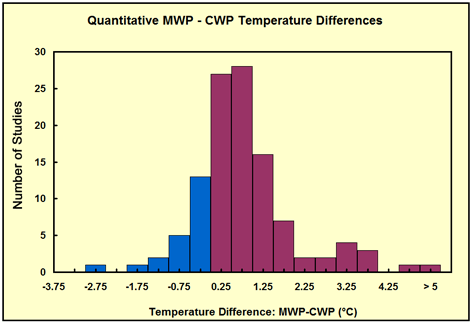An article posted this week on the Nongovernmental International Panel on Climate Change (NIPPC) & CO2science.org websites shows the Medieval Warming Period (MWP) extended to Antarctica with temperatures as warm as the present and that "the present state of reduced ice on the western Antarctic Peninsula is not unprecedented," even within the last thousand years, which stands in stark contrast to the long-held claim of the Intergovernmental Panel on Climate Change that late-20th-century warmth was globally unprecedented over the past one to two millennia." The Medieval Warming Project map site clearly shows that the MWP was a global phenomenon during which temperatures exceeded the present in most studies:
The Medieval Warm Period on the Antarctic Peninsula
Hall, B.L., Koffman, T. and Denton, G.H. 2010. Reduced ice extent on the western Antarctic Peninsula at 700-970 cal. yr B.P. Geology 38: 635-638.
"In a paper published in the July 2010 issue of Geology, Hall et al. (2010) note that (1) "over the past 50 years, the Antarctic Peninsula warmed ~2°C," that (2) "rapid breakups have destroyed several small, thin ice shelves fringing the Antarctic Peninsula," and that (3) removal of ice-shelf back pressure resulted in a marked increase in seaward flow of glaciers discharging into the now abandoned embayments," leading them to ask a most important question: "Is the recent warming of the Antarctic Peninsula unique in the Holocene?"
In an attempt to answer this question, the three researchers "examined organic-rich sediments exposed by recent retreat of the Marr Ice Piedmont on western Anvers Island near Norsel Point," where they say that glaciers "have been undergoing considerable retreat in response to the well-documented warming," which led to their sampling area being deglaciated about six years ago. And based on what they found and describe as "the first record of terrestrial organic material exposed by recently retreating ice that bears on past glacier extent and climate in this sensitive region," Hall et al. conclude that "ice was at or behind its present position at ca. 700-970 cal. yr B.P. and during at least two earlier times, represented by the dates of shells, in the mid-to-late Holocene," which means, in their words, that "the present state of reduced ice on the western Antarctic Peninsula is not unprecedented," even within the last thousand years, which finding stands in stark contrast to the long-held claim of the Intergovernmental Panel on Climate Change that late-20th-century warmth was globally unprecedented over the past one to two millennia.
This finding thus prompted the U.S. scientists to ask another important question: "How widespread is the event at 700-970 cal yr B.P.?" Starting first with the Antarctic Peninsula itself, they write that (1) "Khim et al. (2002) noted a pronounced high-productivity (warm) event between 500 and 1000 cal. yr B.P. in magnetic susceptibility records from Bransfield Basin," that (2) "dates of moss adjacent to the present ice front in the South Shetland Islands (Hall, 2007) indicate that ice there was no more extensive between ca. 650 and 825 cal. yr B.P. than it is now," and that (3) "Bentley et al. (2009) reported that evidence for warming at this time seems restricted to the Western Antarctic Peninsula and is seen best in some (although not all) marine cores (i.e., Domack et al., 2003)," all of which observations suggest, in their words, that "at least in the western and northern Antarctic Peninsula area," the warmth they discovered "is not an anomalous event."
Looking a little further abroad, Hall et al. say their "evidence for reduced ice extent at 700-970 cal. yr B.P. is consistent with tree-ring data from New Zealand that show a pronounced peak in summer temperatures (Cook et al., 2002)," and that "New Zealand glaciers were retracted at the same time (Schaefer et al., 2009)." Moreover, they add that their data "are compatible with a record of glacier fluctuations from southern South America, the continental landmass closest to Antarctica (Strelin et al., 2008)." And, last of all, the timing of the warm interval discovered by Hall et al. (AD 1030-1300) compares well with that of the entire globe, as may be seen on CO2 Science's Interactive Map and Time Domain Plot of their Medieval Warm Period Project.
In conclusion, as ever more relevant evidence is acquired, the case for an equivalent or warmer-than-present Medieval Warm Period grows ever stronger, continually weakening the climate-alarmist claim that the planet's current warmth can only be explained by including the warming they believe to have been produced by the increasing concentrations of atmospheric CO2 and other greenhouse gases that were experienced over the course of the 20th century, all of which gases' concentrations were much reduced back at the time of the equal or greater warmth of the Medieval Warm Period."

No comments:
Post a Comment